Here's how to make great bread without a sourdough starter
A foolproof method of breadmaking, explained.
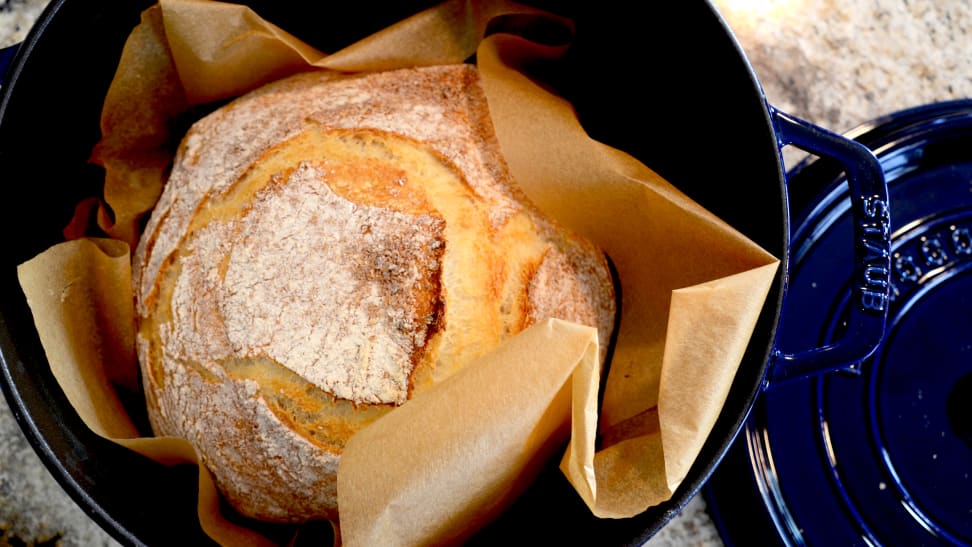 Credit:
Reviewed / Valerie Li Stack
Credit:
Reviewed / Valerie Li Stack
Products are chosen independently by our editors. Purchases made through our links may earn us a commission.
Over the past few years, a lot of us got into making homemade bread. At first we called it #quaranbaking, but then it just became part of our regular routine—or a fun weekend activity. Whether you went the sourdough route, or stuck to easy loaves of bread that didn't require daily care and feeding, you've probably made a lot of loaves to be proud of.
Making sourdough bread from scratch is a great way to learn the ins and outs of breadmaking, but it’s also time-consuming and may not be suitable for people who are just getting into baking. Waiting for the starter to mature takes about seven days, and then there’s the three-day marathon of preparation that yields just two loaves of bread. Though it's definitely worth the effort, not everyone has the patience or resources to wait so long for some simple, crusty bread.
Thankfully, there's an alternative. With the help of some store-bought yeast, you can make delicious no-knead, no-starter bread that requires much less time and labor than traditional sourdough.
What’s the easiest way to make bread without sourdough starter?
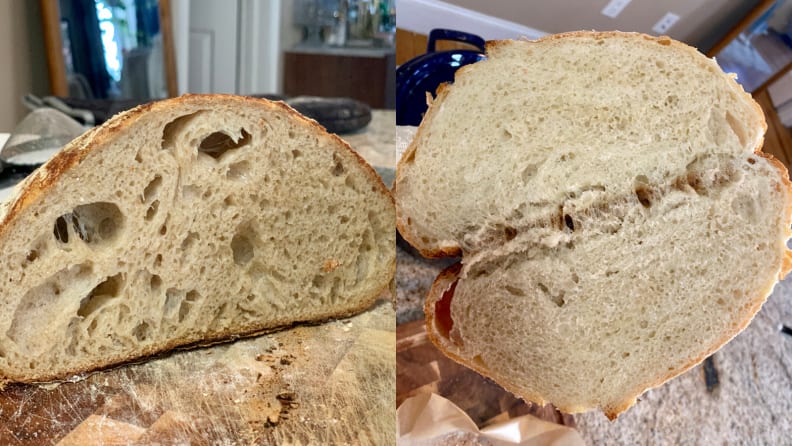
Though this yeasted bread (right) doesn't have as many air pockets as a loaf of sourdough (left), it's still tasty and flavorful.
The keys to starter-free bread are active dry yeast to build the dough and a Dutch oven to create a steamy environment for the bread to develop a fine, crusty exterior. Although this is a “no-knead” bread recipe, I still recommend doing a few rounds of “stretch and fold” if you have the time. This will help with gluten development and therefore build more strength in the final loaf.
For an Instagram-worthy loaf, you'll need a gorgeous crust. A Dutch oven is the ideal cooking vessel for this task as it traps the moisture that’s essential to creating a high quality loaf. Its heavy lid seals the pot tightly enough to prevent the steam from escaping. We love the Dutch ovens from Staub and Le Creuset because they seal in moisture and guarantee even heating.
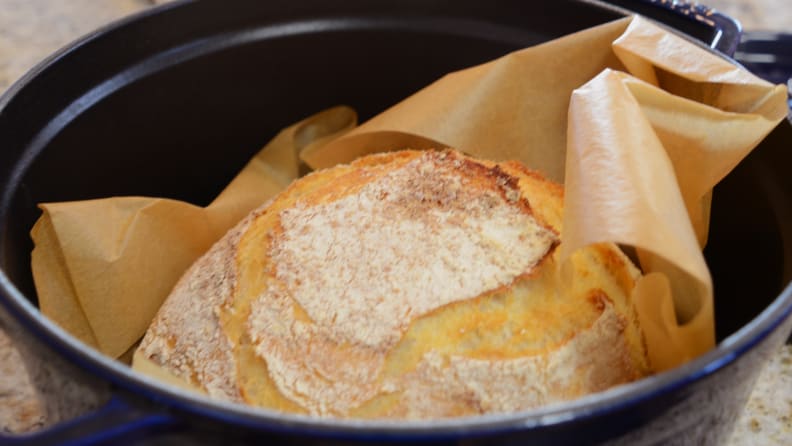
When it comes to bread making, my favorite tool is the Dutch oven.
Don’t have a Dutch oven? Here are a few alternatives to create the steam necessary for a nice crust:
- Use an oven-safe large pot covered by a sheet pan as its lid. Make sure the pot has enough clearance so that it doesn’t touch the top of the oven.
- Use a cast iron skillet. Preheat the skillet with an oven-safe casserole or pan filled with water underneath to create a steam bath.
- Use a pizza stone. Preheat a pizza stone and add a casserole dish filled with water underneath. Bake the bread on the pizza stone.
Here’s how to make my no-knead artisan bread without a sourdough starter.
Recipe: No-Knead Artisan Bread (1 loaf)
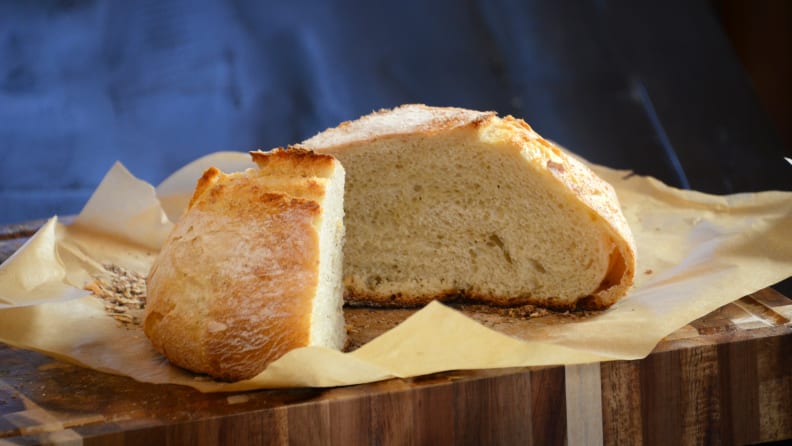
This recipe can help you make soft bread with a crispy crust.
What you need
Ingredients:
- 2 ¼ tsp (9 grams) active dry yeast
- 1 tsp (4 grams) sugar
- 1 ¼ cup (300 grams) lukewarm water
- 2 ½ cups (360 grams) all purpose flour
- 1 ½ tsp (10 grams) kosher salt
Tools:
- A kitchen scale (optional, but highly recommended by professional bakers)
- A Dutch oven (we used the Staub Round Cocotte)
- One large mixing bowl or a stand mixer
- A tea towel or plastic wrap
- A bench scraper
- A proofing basket or a medium bowl
- A lame or a sharp knife
- A cooling rack
Time Needed
1 hour and 45 minutes
Difficulty
Easy
Step-by-Step:
Step 1: Activate the yeast
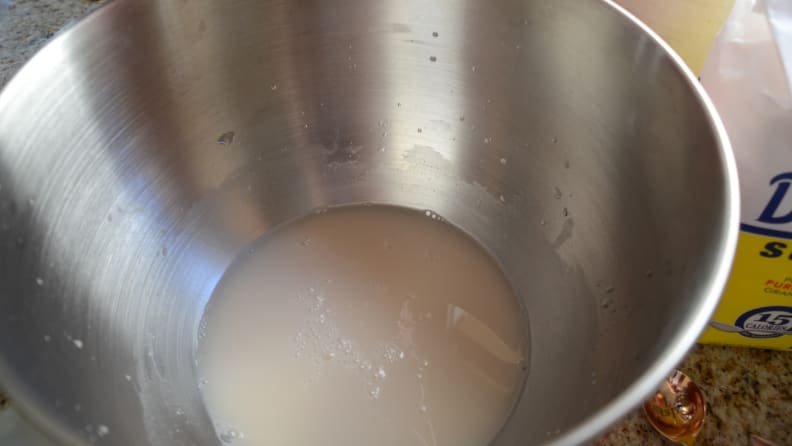
It takes about five minutes for the dry yeast to become active.
In a large bowl (use the mixing bowl if using a stand mixer), combine the yeast, sugar, and warm water. With a spoon or a spatula, mix the ingredients. Let sit for five minutes until the mixture is bubbly and foamy.
Step 2: Mix the ingredients together
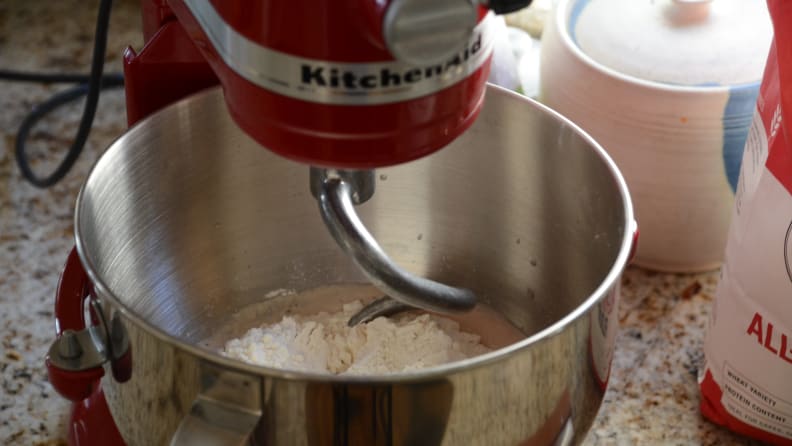
Use the dough hook attachment to mix the ingredients.
In small batches, add the flour to the mixture and stir to combine, then add the kosher salt. If you’re using a stand mixer, attach the dough hook and turn it on low speed. Gradually increase the speed until the dough starts to pull away from the sides of the bowl. If you're not using a stand mixer, use a baking spatula to mix all the ingredients until everything is well combined and dough starts to get stretchy. Dust the dough with a bit of flour and let rest in the bowl under a damp tea towel at room temperature for an hour (the closer to 75°F, the better).
Step 3: Stretch and fold
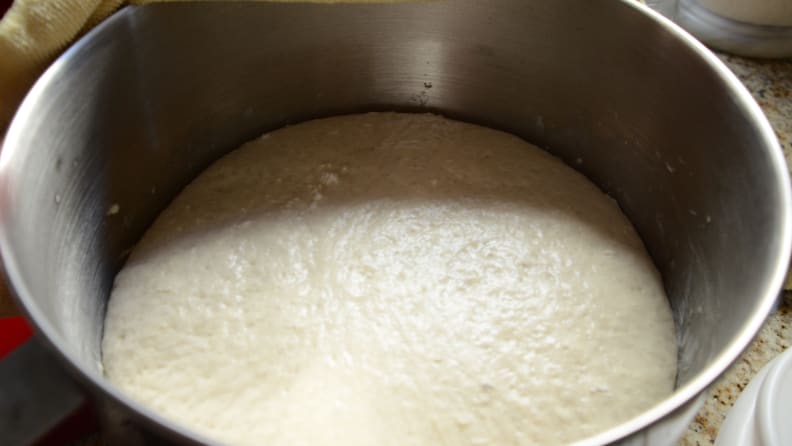
Flour your hands thoroughly, because the dough is a bit slack and may stick.
When the dough doubles in size, tip the bowl and carefully transfer the dough onto a well-floured surface—use a bench scraper to help remove dough from bowl as needed. Flour your hands then pick up the corners of the dough and fold on top. Fold the dough a few more times until you can feel some resistance, then pull the corners towards the center and seal the folds by pinching.
Step 4: Shape the dough
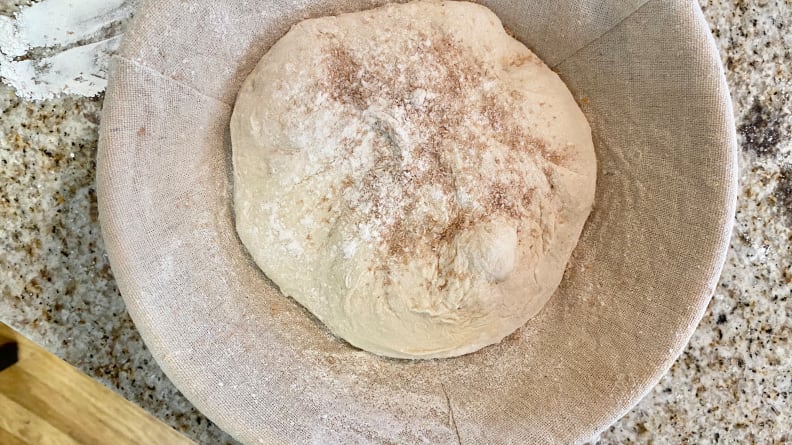
Use a banneton to proof the bread dough before baking.
Dust a proofing basket or a medium bowl with flour (you can also use cornmeal, rice flour, or wheat bran). Use a bench scraper to help pick up the dough and gently place the dough (seam side up) into the center of the basket or bowl. Dust the dough with more flour, then cover the basket with a damp towel and let rest for half an hour at room temperature (again, the closer to 75°F the better).
Step 5: Preheat the oven
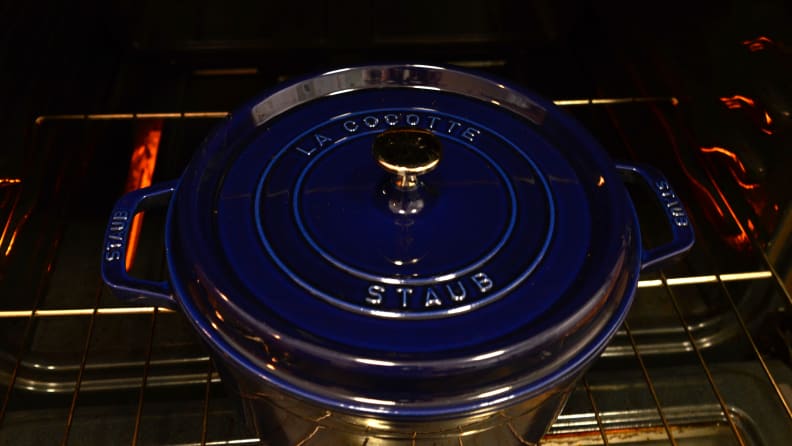
Don't forget to preheat the Dutch oven (or cast iron skillet) while you preheat the oven.
As the dough rests, place the Dutch oven inside the oven and preheat to 460°F (this is my personal preference). In general, you can set the temperature between 450°F to 500°F to make bread, but it also depends on the oven. My oven takes half an hour to reach 460°F, which is how long it takes for the dough to rest in the proofing basket. If your oven takes longer to preheat, then move up this step up to just after forming the dough (step 2).
Make sure the knob on the Dutch oven lid oven-safe, likely made of metal like brass or stainless steel. If you have a plastic knob, unscrew it before preheating and use oven mitts to handle the lid, otherwise the plastic will melt.
Step 6: Bake the bread
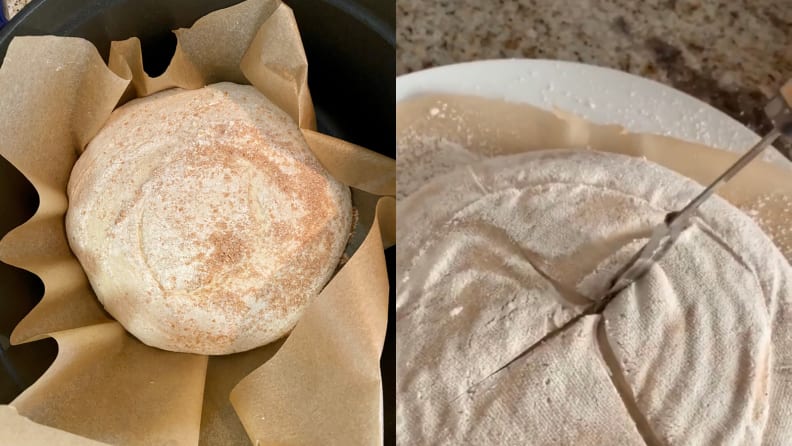
Scoring helps the bread expand without bursting.
Tip the proofing basket and transfer the dough onto a piece of floured parchment paper with the seam side down. Use a lame (or a sharp knife) to score the dough with an “x” or two side-by-side lines before it goes into the oven. Lift the parchment paper by the sides and place with the dough into the preheated Dutch oven. Put the lid on and bake for 30 minutes.
Step 7: Remove the lid and finish
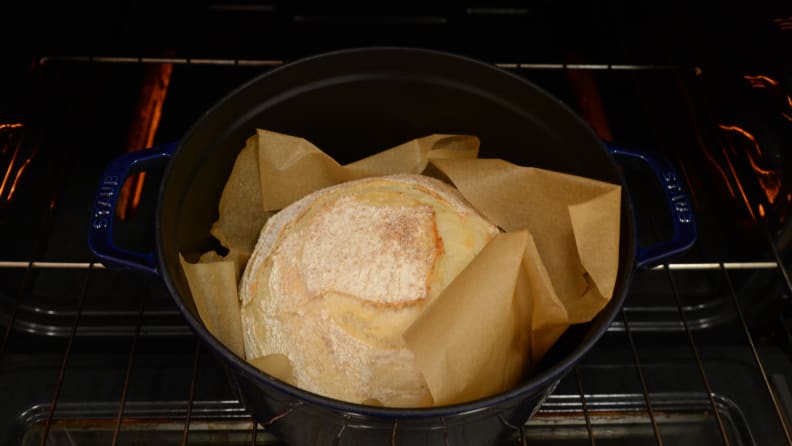
Remove the lid after baking for half an hour.
Remove the Dutch oven lid. By now, the bread should have developed a pale color. Let it bake for another 10 to 15 minutes without the lid until the color darkens. Remove from the oven. Let cool on a cooling rack for 10 minutes and enjoy!
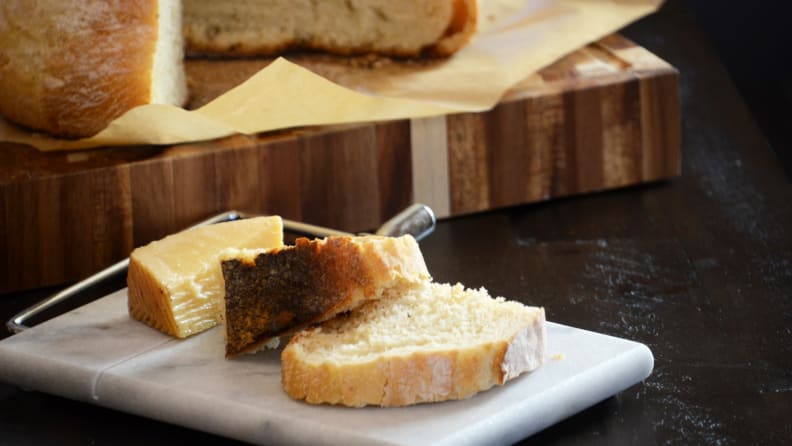
You can store the bread in the fridge for up to a week.
This is a relatively easy bread recipe that doesn’t require a lot of hard work. Even though it the resulting bread might not be as chewy or airy as a slice of sourdough bread, it’s still worth making—and it's a great alternative to store-bought bread. Once you get the hang of it, you can also add dried fruits, nuts, or herbs to suit your taste.


